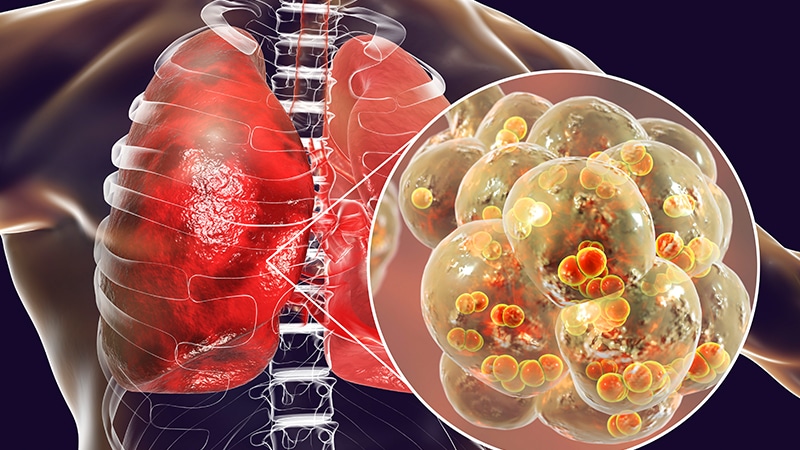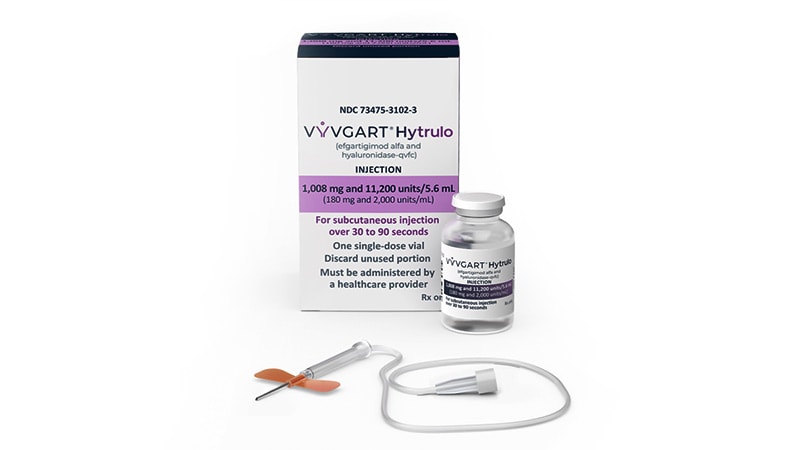This transcript has been edited for clarity. For more episodes, download the Medscape app or subscribe to the podcast on Apple Podcasts, Spotify, or your preferred podcast provider.
Tania Jain, MBBS: Hello, everyone, and welcome to this myelofibrosis podcast series. The topic for today is clinical trials and investigational therapeutics in myeloproliferative neoplasms (MPNs). Our guest in the house is Dr Aaron Gerds, who is associate professor of medicine at the Cleveland Clinic and very well known for his work, including serving as principal investigator for several clinical trials on the treatment of MPNs, and whose efforts are very focused on developing novel therapies in this space. Welcome, Dr Gerds.
Aaron Gerds, MD, MS: Thank you so much, Dr Jain. It's a pleasure to be with you here today and with everybody out there listening.
Jain: Wonderful. When I searched for your bio in researching this episode, it reminded me that you were also the editor-in-chief of hematology for the ASH (American Society of Hematology) newsletter.
Gerds: Yes — ASH Clinical News.
Jain: How was that experience? I am curious.
Gerds: I've done a couple of different things within ASH in terms of editorial work. I also did ASH News Daily. At first you think, well, we're just kind of reporting things that are going on, but it's really a neat way to engage with the hematology community. It makes me think about things that I never would normally think of in my everyday work. I would never think about coagulopathies or bleeding diathesis or thrombosis outside of MPN-related thrombosis, right? It's kind of a neat way to think about what science is going on in hematology, and get that breadth and engage with the larger hematology community: What topics are hot outside my personal area of interest? What political action should we be taking in terms of hematology-related issues? How can we engage with different types of care providers? How can we engage with patients? How can we even engage with industry and other facets of hematology? It's really a neat experience to think about hematology in a very global sense. I get to exercise my creative juices and think about things I normally wouldn't think about. It's been a wonderful experience.
Jain: It sounds like a very comprehensive, out-of-the-box experience.
Gerds: Absolutely.
Jain: We'll get rolling with our topic today. It feels almost like myelofibrosis or MPNs are following some of the trends that multiple myeloma set up a few years ago, in terms of having a nice, full armamentarium, at least in the context of clinical trials and investigational agents. We have pelabresib and other BET (bromodomain and extraterminal motif) inhibitors.
We have navitoclax, the BCL-XL inhibitor. We have navtemadlin, the MDM2 inhibitor; selinexor; LSD (lysine-specific demethylase 1) inhibitors; and others that I'm sure I'm not remembering right now. What's exciting in all of this for you as you treat patients in clinic?
Gerds: You hit the topic right on the head. If you can't be CML (chronic myeloid leukemia), where you have an amazing drug like imatinib that cures people with just a pill, you want to be like myeloma, where there's just a laundry list of available therapeutics to use. In myelofibrosis, we now have different treatment combinations and all types of things to turn a chronic disease into an even more chronic disease. I think we're on that pathway. As you mentioned, not too long ago, we had zero drugs approved for myelofibrosis and zero active therapies.
Now we have four drugs approved, which is just totally remarkable in my mind, especially compared with other diseases, like AML (acute myeloid leukemia). AML has made progress, but in terms of numbers of approved therapeutics, maybe it isn't moving quite as fast as myelofibrosis is right now. I think that's pretty exciting, for a somewhat obscure and somewhat ignored disease for a long time. Certainly, it is exciting. You also touched on the next wave of treatments. We had the big JAK inhibitor wave come through, and now we're on this next wave of attacking pathways that aren't JAK/STAT (Janus kinase/signal transducers and activators of transcription). That is an incredibly exciting prospect because myelofibrosis isn't CML, right? In myelofibrosis, you block JAK/STAT, but the disease still goes on. We've got to hit it from a couple of different angles in order to durably improve outcomes.
Jain: It also feels like we're translating a lot of the science over the past decade into clinically relevant, therapeutic agents. The JAK inhibitors have their role. We know that there are all of these other pathways that can be targeted, as you said, on top of it, or instead of it in some cases, to bring about clinical benefit. That is where it seems like most of the products are headed, whether to use them as a single agent or after a JAK inhibitor. We're thinking about sequential vs hitting with doublets, or possibly triplets upfront in the future, which is what the myeloma world has looked like over the past 5 or 7 years. What are your thoughts about the doublet frontline clinical trials, and how do you see them translating into your clinical practice if they were to become commercially available?
Gerds: You are hitting on such critical points here. If we look back at the past 10 years' worth of single-agent studies of drugs that aren't JAK inhibitors, we see biologic effects for sure. The research showing that these pathways are important is there, biologically in the correlative samples and some of the responses. If you're not hitting JAK/STAT, people generally feel pretty terrible. The cytokine symptoms can persist. The splenomegaly can persist, and you may not have enough time for that new therapeutic to do what it can do, in a very deep sense, against the disease.
JAK inhibitors are well tolerated with good side-effect profiles. Naturally, you would say, okay, well, we can use a JAK inhibitor to continue to hit the cytokines and the spleen size and continue to hold that down, while this other drug can come in and do things in a deeper and more biological way to eliminate disease. That combination makes sense, at least in a worst-case scenario, in an additive manner. There are various bits of preclinical data that say that these two approaches can be somewhat synergistic and multiply the effect of each individual drug. We're not just doing combinations because we're oncologists. For example, we have two drugs and we put them together. It is somewhat empiric, but it's not completely empiric. There's a rationale behind it. It makes sense to look at combinations because JAK inhibitors aren't perfect. If we look at the seminal COMFORT data, the median duration of treatment is 3.2 years. If we look at real-world data, it's much shorter. The median duration with a JAK inhibitor is somewhere, depending on what analysis you look at, between 8 months and 18 months. It is a benefit, but not an indefinite amount of benefit. Therapies that can extend that benefit longer, to me, are going to be incredibly important.
We know that patients whose spleens shrink on therapy live longer. We know that when patients' anemia gets better, they live longer. If we can extend these benefits longer with combination therapy without increasing toxicity too much, we're definitely going to make a big impact. JAK inhibitors alone have provided a benefit. If you look before ruxolitinib's (RUX's) approval, there was a median survival for people diagnosed with myelofibrosis and it went up dramatically after the approval of RUX. JAK inhibitors really do improve survival by doing these things. Not by killing off myelofibrosis cells, but certainly by making people better. At a bare minimum, if we can extend these things further, people are going to live even longer and live better. Then the holy grail, dare I say a dirty word in myelofibrosis, is disease modification. I think we'll be able to do even better than that with these new treatments. I think there's plenty of rationale. And of course, we're all very, very excited about the MANIFEST and TRANSFORM data that were presented at the American Society of Hematology meeting back in December of last year.
Jain: You hit on a term that I cannot let go. You brought it up — disease modifying. That term has changed its color, its meaning, in the context of myelofibrosis over the past decade or two. In your mind, what's a realistic definition of "disease modifying," using the tools we have at hand, in the context of myelofibrosis?
Gerds: It almost gets philosophical at some point, right? True disease modification is just living longer than you would if you didn't have that intervention. By that standard, RUX and other JAK inhibitors would be disease modifying. We use it now, I think, as a shorthand for killing off myelofibrosis cells. How do we measure that? Well, we measure it by changes in allele burden. That's the best tool we have. Or we could look at changes in fibrosis score. Those are going to be your two common ways to "evaluate disease modification." I think we all generally agree that these are not perfect. They don't perfectly correlate with improvements in survival, improvement in symptoms, improvement in splenomegaly, or other key endpoints that we often look at as well. In my opinion, we need to find better markers of disease modification, especially when we talk about changes in fibrosis score. For one, the score is subjective. You can get a panel of people to agree or disagree on the grade and kind of work through that, but it doesn't have a lot of granularity to it. It's just four points and you get a score of 0, 1, 2, 3. When you have a change of grade, does that really mean anything? I don't know.
Lastly, the fibrosis isn't the disease. We're trying to look at a reflection of a reflection of the thing that we're trying to measure. It's passed through all of these filters. Are we truly measuring what we're trying to measure? There are some interesting and cool ways to measure disease modification, like this megakaryocyte density thing that Dr Joseph Scandura does. I think it's really fascinating. There are many others. I could be here all day talking about it. I think we need to, in concert with these new drugs, develop better ways of how we measure the impact on the disease.
Jain: I agree. That's one of the things that our efforts could be focused on now — to identify which out of these truly correlates with overall survival, which is the goal in the context of disease modifying. You mentioned MANIFEST and TRANSFORM, which were presented at ASH 2023 — two much-awaited studies. We'll focus on those two because those were similar in the context of being first-line doublet vs single-agent therapy with pelabresib or navitoclax. The studies had in some ways similar results, but in some ways different results. What are your thoughts about those two trials?
Gerds: These two trials hit on so many hot topics, I could spend hours talking about it. First and foremost, they both were positive studies. They hit on their primary endpoints, period. We had two prospective, randomized, blinded trials that were positive for the primary endpoint. That's amazing. I think we all need to recognize that, and not belittle this and get stuck in a bunch of details when these are two positive trials.
That's been the major challenge right now. Everyone is going into the second- and third-line endpoints and ignoring the fact that both trials were positive. In both studies, the combination of RUX plus pelabresib or RUX plus navitoclax did better in spleen volume reduction at week 24 than RUX alone.
I think that is so incredibly important to note because of all the circumstantial evidence we have that reducing spleen size can impact longevity and quality of life, and all of these other important outcomes. Both are positive trials. Now, I think you mentioned the subtle differences between the trials. The populations of patients were somewhat different on these two trials, which is important to note.
When looking at the key secondary endpoints, particularly symptom burden improvement, neither trial hit on that secondary endpoint. With a clinical trial, you get to answer only one question. Both studies answered the question; the answer was yes. But for the second question that we kind of like to add on, the bonus question, the answer was a no, on both trials.
There was a numeric improvement in symptom burden with the pelabresib combination, but there wasn't with the navitoclax. I would also say symptom burden was not worse with the combination. When you have one drug vs two drugs, you would suspect that the two drugs would be more toxic, having more side effects, possibly worsening symptoms or worsening quality of life, vs one drug. But they didn't. So navitoclax was very similar in its symptom burden in the two study arms, and pelabresib, again, had a numeric improvement in symptom burden. I think that's so incredibly important, especially if you look at the TRANSFORM data. The combination of RUX plus navitoclax did not make people worse. It shrunk more spleens and did not make people worse in how they felt. That is so important. That's what I see when I see those two endpoints.
Now, you had mentioned earlier that we need to get away from these endpoints. Well, there is a movement away from these endpoints and I am in favor of that. These endpoints are great. We should always measure them. They're historic. I think they correlate with people doing better in general, whether we're talking in terms of quality of life or survival. But there's so much more to this. There's treatment durability. There's obviously overall survival, anemia improvement, as we saw with pelabresib, and then these other markers of "disease modification" that we touched on earlier.
There are so many other key secondary endpoints that it lessens the importance of symptom burden improvement when RUX already does a great job. If RUX is such an amazing drug at improving symptoms, why are we trying to do better? I mean, we always want to do better, but is it realistic to want to do better than that? Saying that this wasn't a successful trial just because the symptoms didn't make it — a secondary endpoint, I think, is something we should stop and think about critically before we move on to that conclusion.
Jain: I agree. As investigators or scientists or clinicians, we're not always thinking about trial endpoints in the same was as a regulatory agency. That is where the conflict or discrepancy in thinking is right now. And I wonder if this is something worth presenting to our regulatory bodies as clinicians who take care of patients, and as investigators who design trials with realistic feasible endpoints. If you were to design an ideal trial in your mind, if that exists — let's say we're in a parallel universe — what kind of endpoints would you be looking at in terms of designing your trial? What endpoints are you using to try to convince regulatory agencies that this is what you think is most important?
Gerds: I think it's a conversation, right? And change is not going to happen overnight. I think it's really on us and the MPN community to continuously go to the regulatory authorities and say, "Look, this is what's important now" and keep emphasizing these points over and over and over again. There was a listening forum that the FDA had a year or two ago, where they brought in patients and MPN experts. Everybody sat down and asked, "What is important?"
I think we need to continue to encourage folks to do that and collaborate with the FDA and other regulatory authorities. That is clearly the only way forward here. If I had all the authority in the world to design trials, I think there are some interesting designs to reference. You brought up something very early on in the podcast about monotherapy vs combination therapy, particularly in the upfront setting. We all have tons of patients who do very well on single-agent JAK inhibitors for a very long time. Why would we risk toxicity or side effects or other issues, including cost, by using combination therapy? Two drugs are probably going to be more expensive than one drug. How do we understand that?
There are some cool trial designs out there right now. There's an MDM2 inhibitor that's in development, navtemadlin. There's a clinical trial that has an interesting design where everybody goes on standard of care, RUX, and if patients do great, they continue on the RUX. But if they're not hitting critical markers at certain time points, at 3 and 6 months, they go on to combination with navtemadlin. And that's a really pragmatic way of going about things. That's how we would do things in everyday practice, right? If your listeners are not familiar, there's this model called the RR6 model, which I think is a very simple way to think about this — at 3 and 6 months. Are you on RUX 20 mg twice daily? Has your spleen shrunk by 30% in volume as best you can tell by palpation? Are you transfusion dependent? If things are all positive for those three markers, you're doing great and you're going to do great on RUX.
But if you're not there, then you should think about alternative therapy. That's how we already think about things in practice. This trial kind of matches that. I really liked that trial design. Another trial that is ongoing that I think should be a model is the imetelstat trial; it's a prospective randomized phase 3 trial. The primary endpoint is overall survival. That's a black-and-white endpoint. There's no wiggle room there. If patients are living longer, you're making a big impact and you're modifying disease. No questions asked. I think we need to do more of that. Looking back at MANIFEST and TRANSFORM, I think we need to exercise patience there to wait for that kind of data to come out.
We're so quick to judge on the primary endpoint looking at the early data, the week 24 data. That's too early; this is not AML. In AML, you get a CR (clinical response) rate in a month or two, and you can kind of say, yep, great, or nope. You also want survival data to back that up, but you get these early indicators in the AML trials. We all have Amazon accounts; we order something tonight and we want it tomorrow morning. But when you order from other places, sometimes it takes a week to get to you, and that's okay. If we have to be a little more patient with these trials… Let's hold tight on navitoclax, right? The TRANSFORM data, if we continue to follow it, might show some great benefit. The phase 2 data were interesting in terms of disease modification potential.
If we just hang tight and watch this thing instead of bailing on it because it didn't hit a secondary endpoint, that may not have value anymore anyway in the current era, then we would lose a potential therapy. I don't want to lose potential therapies that could be beneficial. If we take something all the way to phase 3, there's potential there. I really think it behooves us to do it, and the onus is on us to follow through.
We must have these continuing conversations with the regulatory authorities. We need to continue to move their frame of reference to what care is today for myelofibrosis and not what it was a decade ago. Open, constant communication, and building relationships with regulatory authorities and with industry, are going to be so critical to getting these new therapies out there.
I know we have some MPN specialists who are now working at the FDA, which is always good news. I think the community looks very favorably upon that development and should hopefully help us move these things forward.
Jain: I agree. I think those discussions are happening and I think they are critical. The last topic we'll talk about is toxicities. In terms of financial toxicities, there are no free rides, right? When we add a doublet, we add double — or maybe more or less — the cost upfront. Does everybody need that? How do you think about that in the context of these agents that hopefully will become available in the near future?
Gerds: Certainly, the cost will be additive. No doubt about it. If we continue this path, I don't know if our healthcare system can sustain these increasing costs, in any type of manner. We have to be responsible there, too. There are so many patients who do well on a single-agent JAK inhibitor. Do they all need to be on combinations? Probably not. Even if TRANSFORM or MANIFEST-2 leads to an approval for these drugs in the frontline setting, I still think we can take an approach where you do try single agent for a short period of time.
If there's benefit early on, great — you stick with single agent. But if there is not a benefit within a certain period, say 3 months, just as an example, then you switch to the combination. There are plenty of phase 2, second-line data for pelabresib. There's an ongoing second-line study for navitoclax. In addition to the phase 2 trials, there's plenty of data. I don't think you're going to lose much by doing single agent for a month or two just to see how the response is going to go, and then going on to combination vs combination from the very start.
I don't have data to prove that, but I think it's a very practical way to minimize the financial impact of combination therapy.
Jain: That sounds wonderful. Not everyone needs doublet therapy upfront. The challenge is that we don't know who needs a doublet. If only we had biomarkers to predict who will probably need a doublet… The only way to do that right now is, like you said, do a trial of JAK inhibitors alone for a month or two or three before you add on the second agent. There's not always that rush of fixing things right now. One of the important things to recognize in the context of myelofibrosis, being a chronic leukemia, is that it's a slowly evolving disease. You have time to pause and think about your strategy.
Gerds: You made some parallels earlier to multiple myeloma, and I would do that again here. We're not putting people in VGPRs (very good partial response) or remissions with these combinations, as far as we know. You do triplet or quadruplet therapy for myeloma to get these people in these deep remissions so they can have this period before their disease comes back.
This is different. We're just pushing back gently. We're not putting people in remission. That approach makes a lot more sense than it would in a multiple myeloma. That's a big distinction that I would like to make and why it's rational to do something like that.
Jain: Absolutely. All right. With that, we'll end our podcast. We had a great discussion with Dr Gerds about how to think about the novel agents that are in the pipeline and moving up the ladder, and hopefully some of them — or maybe all of them — will become commercially available to our patients at some point. Along the way, we'll learn who needs a doublet therapy or what is the right strategy for adding on a doublet therapy to the JAK inhibitor backbone, which continues to remain an important therapeutic strategy in MPNs. We will continue to think about endpoints or the best trial design. We will keep in mind trying JAK inhibitors alone for some period of time and then adding a second agent on in those who need it, vs leaving those who are benefiting on single-agent therapy. This was wonderful, Dr Gerds. I appreciate you taking the time, and we will meet with our audience again in our next episode. Thank you very much.
Resources
Bromodomain and Extraterminal (BET) Proteins: Biological Functions, Diseases, and Targeted Therapy
Defining Disease Modification in Myelofibrosis in the Era of Targeted Therapy
A Prognostic Model to Predict Survival After 6 Months of Ruxolitinib in Patients With Myelofibrosis

.webp) 3 days ago
4
3 days ago
4


























 English (US)
English (US)